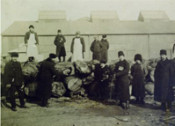
Anniversary of foundation of the Blagoveshchensk customs outpost in the Amur Region
30 April (13 May), 1902 the Senate issued a decree of the Minister of Finance of the Russian Empire, about the opening of the customs outpost in Blagoveshchensk – thus began the creation of customs agencies at the state border between Russia and China.
The first mention of the need for customs surveillance in the city of Blagoveshchensk refers to 1895, when, in connection with the forthcoming abolition of free ports and the introduction of customs duties over the goods imported to the Amur Region, government circles began to intensively worked out the issue of strengthening of the state border, and, consequently, of establishment of a network of customs agencies. V. P. Debil’, Irkutsk Customs’ Head, sent to the Amur region as a member of the commission approved by the emperor to examine the state of the land and maritime border, noticed the benefits of the geographical location of Blagoveshchensk and offered to make it the center of a newly established customs districts. The need for a customs office in Blagoveshchensk, located in the 50 versts area of free trade with China, was not called in question.
Blagoveshchensk customs outpost began its work with two customs officers and 10 inspectors; seven years later it was one of the most important customs in the Amur region in terms of activity and range of tasks. With the reorganization of the management of customs authorities in the Amur region and the creation of the Amur customs district, changed the status of the Blagoveshchensk customs outpost. May 26 (June 8), 1909 by order of the Russian Minister of Finance, the outpost was transformed into the customs office of the 2nd class. In accordance with the Charter of the Customs, the agency was authorized to allow entering and cleaning duties of all the goods "permitted for import". The staff of the new customs was increased to 10 officers and 35 customs inspectors.
In May 1910 funds were allocated for the acquisition of real property for the Blagoveshchensk customs: now it had its own building – a plot and the building on the corner of the Amur Embankment and Masterskaya Str., which was purchased from the Association of the Amur Shipping Company. By 1911 the circulation of documents had increased more than twice; the number of forfeiture cases increased by 20%, significantly increased revenue to the treasury. The load on each customs officer had also repeatedly increased. Therefore, to meet new challenges, from (14) January 1913 the Blagoveshchensk customs was transformed into the 1st class customs.
In 1914, the growth of contraband arrests by the Blagoveshchensk Customs increased almost 1.5 times compared to 1913. The smuggling reached unprecedented level in the First World War (1914-1918) - the number of arrests in cases of smuggling has increased in almost 2.5 times. In the first post-revolutionary year, in terms of political instability and change of rule, the Blagoveshchensk customs had to solve the previous problems. The Civil War and intervention greatly weakened the customs border protection.
With the formation of the Far Eastern Republic in April 1920, began the restoration of the customs agencies. In ensuring border security, the Blagoveshchensk customs worked closely with the military authorities. Following the approval of Soviet power in the Far East region, the Blagoveshchensk customs along with other customs agencies of the Republic, became part of the Far Eastern Customs District (DVTO), created in December 1922, and was subject to the Office of the Blagoveshchensk customs inspector. DVTO abolition in 1925 and its replacement by the Far Eastern Branch of the State Customs Department were accompanied by changes in the structure and subordination of customs agencies. In 1934, the Far Eastern Branch of the State Customs Department relocated from Khabarovsk to Vladivostok, and in February 1938 it was eliminated. Its functions were given over to the Vladivostok customs. A number of customs authorities in those years were abolished, including the Blagoveshchensk customs.
The permanent customs control in the Amur revived after World War II. In October 1945 as part of the Vladivostok customs were opened ten customs offices, providing the customs surveillance along the border with Manchuria. Among them, began to act and the Blagoveshchensk customs office with a staff of three people. From April 1946 the customs post started to operate on a permanent basis, and June 27, 1989 it was converted into customs.
In 1993 JSC "AmurAsso" built a capital building of the passenger checkpoint, which has been constantly expanding and has now turned into a large complex of modern international river passenger station. Throughout the history of the customs office, it has developed cooperation with customs officers of the Heihe and Sunke Customs of the People's Republic of China. The major counterpart countries on import trade transactions are: China, USA, Sweden, the Philippines and Kazakhstan.
Lit.: Благовещенская таможня: регион ответственности таможенного органа и деятельность таможни в пресс-релизах с 01.01. по 01.11.2010 г. Благовещенск, 2010; Благовещенской таможенной заставе на Амуре — 100 лет: Информационный бюллетень № 4. Благовещенск, 2002; Таможня на Тихом океане: документы и материалы. Вып. 1. Благовещенская таможня / Н. А. Беляева, Н. А. Троицкая, Е. Д. Яворская. Владивосток, 2002. С. 5—11.
The material provided by the Muraviov Scientefic Library of the Amur region

